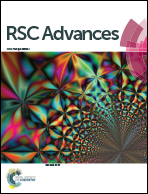Electrochemically dealloyed nanoporous Fe40Ni20Co20P15C5 metallic glass for efficient and stable electrocatalytic hydrogen and oxygen generation†
Abstract
The anion exchange membrane (AEM) in fuel cells requires new, stable, and improved electrocatalysts for large scale commercial production of hydrogen fuel for efficient energy conversion. Fe40Ni20Co20P15C5, a novel metallic glass ribbon, was prepared by arc melting and melt spinning method. The metallic glass was evaluated as an efficient electrocatalyst in water-splitting reactions, namely hydrogen evolution reaction under acidic and alkaline conditions. In addition, oxygen evolution reaction in alkaline medium was also evaluated. In 0.5 M H2SO4, the metallic glass ribbons, after electrochemical dealloying, needed an overpotential of 128 mV for hydrogen evolution reaction, while in 1 M KOH they needed an overpotential of 236 mV for hydrogen evolution. For the oxygen evolution reaction, the overpotential was 278 mV. The electrochemical dealloying procedure significantly reduced the overpotential, and the overpotential remained constant over 20 hours of test conditions under acidic and alkaline conditions. The improved electrocatalytic activity was explained based on the metastable nature of metallic glass and the synergistic effect of metal hydroxo species and phosphates. Based on the excellent properties and free-standing nature of these metallic glass ribbons in electrolyte medium, we propose the current metallic glass for commercial, industrial electrocatalytic applications.



 Please wait while we load your content...
Please wait while we load your content...